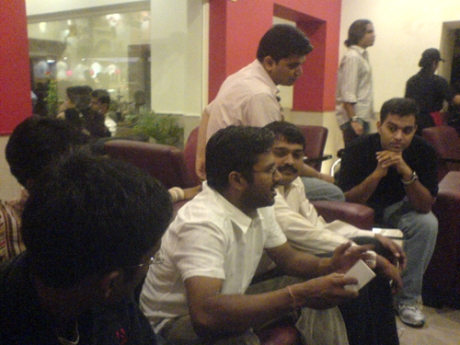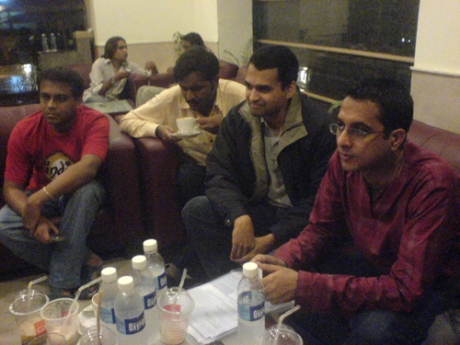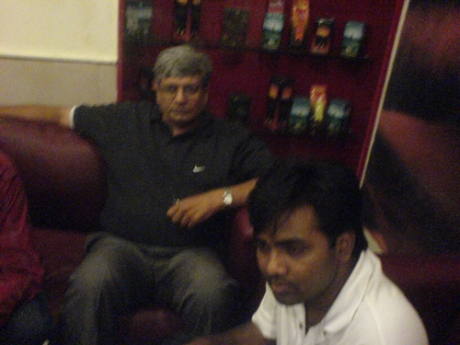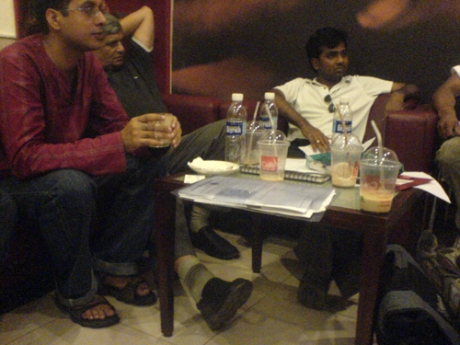Track your expenses the Buxfer way !! November 19, 2006
Posted by rajAT in buxfer, startup, venture capital, web2.0.14 comments
Last week I had a chat with Amit Manjhi the guy behind payments website called Buxfer.com. Other 2 co-founders are Ashwin and Shashank. All 3 are doing their phd at Carnegie Mellon.
Amit told me that Buxfer started more from the their own need. It was difficult keeping track of the group expenses. So the more enterprising guy Ashwin created a script to track their money. It was really useful and loads of people asked them to share it with them also. That is when they saw the apple falling created Buxfer.
We started talking about the various other things and quickly find out some common friends. So very Indian :D. Aur phir dilli ki baatein shuru ho gayi jo kabhi khatam na hon :D. It was real fun.
Its real nice to see people doing innovative things to make our lives simpler. Keep up the good work guys. 🙂
Charles River Ventures – New Investment Strategy November 3, 2006
Posted by rajAT in entrepreneur, startup, vc, venture capital.3 comments
I have blogged earlier here and here that present VC model is broken and it should be chnaged.
Charles River Ventures, an early stage venture capital firm, has launched a new investment strategy, offering rapid but tiny $250,000 checks to Internet start-ups.
The advantage of a seed round is that it done as a “convertible” loan, which means the $250,000 is essentially a no-strings-attached loan to an entrepreneur. There is no equity stake claim by the investor at the time, which is good for the entrepreneur, who can see how good his idea is first. If the idea gains traction, he can raise money in the series A and negotiate a high valuation for his company. If he can command a $5 million valuation, for example, the investor’s $250,000 seed money converts into only 5 percent of the company.
There is almost no liability for the entrepreneurs, because the loan is made to a corporation formed around the entrepreneur. If the company fails, the company goes away, and the founders aren’t liable.
From CRV’s site for an example:
If CRV loans your company $100,000 with a six percent interest rate, and six months later the company closed a Series A round, at that point the loan balance (with interest) would convert at a 25% discount (value = loan dollar amount plus interest / .75) into $137,333.33 worth of Series A stock. Given that seed funding amounts are typically very small compared to the amounts one might expect to raise in a Series A round, as the example illustrates, the aggregate discount amount, in this case $37K, is a tiny fraction of what is likely to be a multimillion dollar Series A financing.
Its good to see that VCs are trying to change their ways of working also. After all we entrepreneurs are their customers and they should keep us happy. 🙂
YouTube – From Concept to Hypergrowth November 2, 2006
Posted by rajAT in jawed karim, startup, youtube.add a comment
This is a 50 min. talk/presentation by Jawed Karim – one of the three YouTube co-founders – about how and why (social networking) sites like YouTube became so popular in the last couple of years. Although it focuses on the bigger known services this is very interesting to watch. Specially towards the end (last 10 min. or so) there is a lot to learn about why YouTube works/what made it work – recommended for anyone who has to do with social networking sites or wants to better understand them…
Building the right mobile app November 2, 2006
Posted by rajAT in india, mobile, startup.1 comment so far
Well the title over promises. I am not going to dole out lot of gyan for building the right app for the mobile. Just narrating some experience that I had in Delhi. One of the mobile enthusiasts there asked me if I can give some feedback on their idea that he and his friend have been mulling over. I was delighted as he thought me worthy enough for the job. We met at PVR Saket. I bet not a great place to meet and discuss mobile VAS. There is so much girls around ‘Value getting created‘ and we are missing all the fun ‘Value not captured‘ :). The idea was interesting and guys have done some homework as in how to build the app. I was impressed at that. But then when I asked some of they important questions as in
a. What is the business model ?
b. How the value is getting created in the value chain ?
c. Are they capable to capture that value for themselves ?
d. What is the USP ?
And numerous others on the same lines. There were no clear answers for any of them. They were mixing the USP with other things and there were whole lot of other issues. Guys took it coolly. Meeting ended.
Today while browsing I found some more interesting tips by Sprint’s Vice President for Partner Development and Product Innovation Paul Reddick. Here they are –
1. Know thyself — consider your scope carefully and be specific of what you do that is better than everything out there.
2. Know if you are a mass market or a niche application — mass market is hard to get right, because it has to be popular to such a wide audience. But also if you’re a niche application don’t expect to be placed on the deck.
3. Educate objectively before selling passionately — carriers see a lot of ideas, don’t oversell it.
4. Admit what you’ve accomplished versus trying to sell what is really a work in progress.
5. Be specific about what you want from the carrier. And know what the carrier has deployed in the market — at CTIA he says he had a guy pitching him an application that they had launched three years ago.
6. Provide differentiation.
7. Adapt to new models — he gives the example of Sprint bundling applications with the handset, which he says is a risky move and a big shift for Sprint.
8. Leverage new capabilties — like WiMAX.
9. Avoid asking him why your application can’t be on the Sprint’s deck — he says he hears a sense of entitlement. Go off deck.
10. His team focuses on finding innovation that can fix technology and service bottlenecks. Keep that in mind.
But all salutes to the guys for their passion. I sincerely hope they might be either refining their plans or thinking on new lines.
All luck.
Tie Con Delhi 2006 November 1, 2006
Posted by rajAT in india, startup, tiecon delhi.1 comment so far
 Last weekend I was in Delhi attending TiE Con 2006. The event was action packed. Met lots of interesting people in the conference.
Last weekend I was in Delhi attending TiE Con 2006. The event was action packed. Met lots of interesting people in the conference.
The best part of 2 day session was from Vivek Ranadive. I am reproducing here the post from my friend Nikhil. He invited me for a rock gig but I couldnt make it due to time constraints. So here is the post ..
The Keynote address on Day 2 at TiEcon 2006 was delivered by Vivek Ranadive, Chairman and Founder of TIBCO narrated his story in a wry self deprecating manner, and offered advise to entrepreneurs based on his own experiences. Giving his own example of enterprise, on how he persevered and eventually got some of his (according to him) ‘smarter’ friends to join his business after he received seed funding, his first offering bit of advise: surround yourself with people who are smarter than you. He began his company at a time when there was little funding, but he had an idea of a “software bus” that he wanted to implement. After receiving his funding, he talked his was into the Goldman Sachs office and convinced the newly appointed head to allow him to digitize wall street. He was among the first people to go down on to wall street and talk to the traders on how they actually worked and this helped them plan their implementation better. So – Listen to your customer and really understand how to help them. Forget about the competition, he reiterated – listen to the customer. He joked that Reuters had been a competitor for them, since because of thier digitization, the Reuters business at Wall Street was actually suffering. When Reuters bought TIBCO, he learnt that internally, people at Reuters had referred to TIB in TIBCO as ‘That Indian Bastard’. After Goldman Sachs, their next big deal was with Solomon Brothers who wanted to put the entire bond system on digital. IBM was among their competitors, and he was called for a lunch meeting where the CIO of Solomon Brothers asked him why they should do business with TIBCO? Ranadive repeatedly spoke about his product, his people and the company. When the CIO asked him again about why they should do business with him, Ranadive looked him straight in the eyes and said – “Because we have fire in our eyes”. That later became a joke at Solomon Brothers, but it is important to have passion, he said.
photo courtesy – http://www.amitranjan.com
Kinks in VC Industry October 9, 2006
Posted by rajAT in entrepreneur, startup, vc, venture capital.3 comments
The high-risk, high-return venture capital business may have turned into all risk and no return.
“The traditional venture model seems to us to be broken,” Steve Dow, a general partner at Sevin Rosen Funds, said in an interview.
Sevin Rosen, a 25-year-old firm that is among the most respected in the industry, was in the process of closing its 10th fund and had received commitments from investors for $250 million to $300 million, Mr. Dow said. But in a letter sent to those investors yesterday, Sevin Rosen said it had decided to abort that process.
Explaining its decision, Sevin Rosen, which has offices in Dallas and Silicon Valley, said that too much money had flooded the venture business and too many companies were being given financing in every conceivable sector.
But excess of capital is only part of the problem, the firm said. In its letter, it bemoaned what it described as “a terribly weak exit environment,” a reference to the dearth of initial public offerings and to a market for acquisitions at valuations that it considers too low to deliver the kind of returns that venture investors expect.
Fred Wilson at A VC says that all this doesn’t mean that the “venture capital model” is broken. It means that we have to adapt to the changing nature of the technology business.
The big trends they saw when they raised the money for Union Square Ventures are following –
1 – commodization of the core infrastructure of the technology business
2 – community powered development environments – ie open source
3 – software delivered as a service over the internet
4 – a movement toward lightweight web services – ie web 2.0
5 – the globalization of technology development and consumption.
He suggested changes that VC model should be tweaked in the following ways.
- We’ve got to raise smaller funds.
- We’ve got to do less “hard tech” and more “soft tech”
- We’ve got to figure out how to make great returns on $100mm to $250mm exits
- We’ve got to limit our IPOs to our very best companies.
I actually think that many firms have already made many of these changes as part of the brutal restructuring of the venture capital business in the 2001-2003 time period and are much better off because of it.
I am not sure that model has already got tweaked becasue old VC ways are still continuing.
- VCs still raise big funds. Couple of VC have raised billion dollar funds.
- Pure idea plays get copied very fast. Look at the video uploading websites that have cropped up. And VCs are not very comfortable with this.
- Exit strategy is M&A. IPOs are a pipe dream.
And all this is so true if we see in Indian context. Here entrepreneurs doesn’t need big money to start and that put them out of the radar of all the VCs.
Good news is that now lot more people are talking about the change in VC industry and so lets hope it will happen soon.
Technorati tags: VC, venture capital, startup
Bootstrap Hyderabad September Meet September 25, 2006
Posted by rajAT in bootstrap, entrepreneur, hyderabad, startup.5 comments
Bootstrap Hyderabad’s september meet was a big hit. The house was packed.
Mohit has blogged the event here. The pics from the meet are below.

Vishal gave really useful suggestions. ( in pic Vishal, Mangesh, Mohit, Mallaya)

People listening intently to Vishal here ( in pic Anand, Siva Prasad, Rajiv, Amit )

More crowd listening to Vishal ( in pic RK, Vijay)

Caffeine

Anand suggesting that next time we can use big office of pennywise. :).

Ritesh Prasad kicked Adobe 🙂 and is fellow bootstrapper now.

Gyaan sharing going on.
Meeting just rocked. Eagerly waiting for the October meet.
India’s Young Entrepreneurs August 23, 2006
Posted by rajAT in entrepreneur, entrepreneurship, india, startup, tye.30 comments
TEENAGE TITANS – For the past month or so, BusinessWeek.com has set out to find Asia’s most interesting examples of this new breed. They asked readers to nominate standout young entrepreneurs 25 or under, and narrowed down the impressive list to a group of finalists.
I am listing out the people who made it from India.
All these young folks share an unbridled enthusiasm and a fierce desire to succeed. Will all of them make it? Maybe not. Yet this much is clear: India’s already dynamic future has turned a little bit brighter with the arrival of this bunch.
 Sasikanth Chemalamudi
Sasikanth Chemalamudi
CEO: Habits
http://www.habits.in
Hyderabad, India
Age: 23
A graduate with honors from the Birla Institute of Technology & Science in Pilani, Chemalamudi turned down an offer from outsourcing powerhouse Infosys to pursue his passion for entrepreneurship. He co-launched Habits, a creative learning resources company that encourages more creative thinking with the aid of educational materials such as musicals, plays, and interactive games. Habits is also involved with projects in rural India to encourage self-employment.
 Rama Krishna Gaddipati
Rama Krishna Gaddipati
Co-founder: Bridle Information & Technology Solutions
http://www.bridleit.com/index.htm
Tenali, India
Age: 24
Bridle is a mobile applications and services outfit—and that is a good space to occupy given the explosive growth of mobile telephony in India. And Bridle co-founder Gaddipati (the 2001 winner of the Intel CyberFiesta national software development contest) may already have a hit on his hands. The service is called SchoolMATE, and it is a comprehensive student analysis system that allows parents to monitor their child’s progress at school. The service feeds information on conduct, examinations, and report cards to subscribers, and employs technology such as mobile text messaging, the Web, and e-mail. The company has gained about 70,000 subscribers in Hyderabad and Vishakapatnam in India.
 Vikas Kedia
Vikas Kedia
Founder & Partner: MobiTrail
http://www.mobitrail.com
Bombay, India
Age: 25
The next big platform shift in online gaming will be to mobile handsets, and Kedia thinks his company is positioned to capture that growth. This 25-year-old programmer based in Bombay is founder of MobiTrail, which develops and delivers games to mobile phone users. Its games and applications can run on networks using J2ME, Symbian, and BREW operating systems. The company is developing some hot games of its own and has such clients as Reliant Online Gaming in India and Hong Kong-based Mobile2win, as well as other international customers.
 Atul Prakash Khekade
Atul Prakash Khekade
Co-Founder: Innovation Trip
http://www.innovationtrip.com
Bombay, India
Age: 24
Khekade launched his first business, a Web technology and software applications company, at 17, and has written a book on graphical user interfaces. Now the University of Mumbai-trained engineer and scholarship recipient is trying his hand at the business tourism market. Last year he co-founded Innovation Trip, which sets up U.S.-based workshop-and-trip combos for senior executives in the developing world interested in the latest best-business practices in the States.
 Vishal Sampat
Vishal Sampat
Founder: Convonix
http://www.convonix.com
Bombay, India
Age: 24
Sampat caught the entrepreneurial bug early in life. While still in his teens, he launched his first venture, a streaming online music radio service featuring Indian tunes. His latest venture, launched in 2001, is Convonix. It is an Internet marketing firm with more than 35 employees that helps clients enhance their online traffic and get better placement in search engine results. The company has also developed its own Web analytics and campaign management programs.
 Divyank Turakhia
Divyank Turakhia
Co-Founder, President & Director: Directi Group
http://www.directi.com
Bombay, India
Age: 24
Turakhia tried his hand at Internet consulting in high school at age 14 and, two years later, launched Directi Group with $600 borrowed from his parents. In the first month of operations, the business managed to generate enough revenues to return the borrowed amount and get the company rolling. Today, the company is debt-free, has more than 1 million customers for its array of domain name registration, Web hosting, and site building services, and employs more than 250 people. It is one of the fastest-growing domain registration companies in the world. When Turakhia isn’t running the show, he pursues hobbies such as sky diving, paragliding, and flying airplanes.
TePP – Technopreneur Promotion Programme July 3, 2006
Posted by rajAT in dsir, entrepreneur, entrepreneurship, india, startup, technology, tepp.5 comments
The Technopreneur Promotion Programme(TePP) is a novel programme to extend financial support to individual innovators for converting their innovative ideas into working prototypes/models. Jointly operated by the Department of Scientific & Industrial research(DSIR) and Technology Information, Forecasting and Assessment Council(TIFAC) of the Department of Science & Technology(DST), TePP endeavors to tap the vast innovative potential of the citizens of India.
I met Mr. A.S. Rao at ISB today. He told me TePP is very actively seeking for innovative ideas and is very proactive in their approach. The list of projects that have got funded by TePP are here.
Some of the salient points of TePP are –
Who can apply
Any Indian Citizen with an original idea/invention/know-how to develop working prototype/processes can apply for TePP support. Even, the proposal from the owner of a ‘start-up’ company/industry may be considered for TePP support, if the annual turnover of the company / industry doesn’t exceed Rs. 30.00 lakh per annum.
Amount given
The maximum TePP support would be up to 90% of the project cost . The remainder part of the cost i.e. 10% amount in the project would be invested by the applicant. The upper limit for TePP support for the proposal at present is Rs. 10.00 lakh.
IP ownership
The ownership of IPR generated through the TePP projects rest with the innovator/applicant. No sharing of IPR by the forwarding/sponsoring agency will be permitted. The Ministry of Science & Technology(MOST) does not own any responsibility for disputes arising out of the IPR issues, however, the rules and regulations of NRDC or PFC of TIFAC will apply for those projects supported for patents applied by DSIR and TIFAC respectively.
Is venture investing a gut business ? June 30, 2006
Posted by rajAT in entrepreneur, startup, technology, vc, venture capital.5 comments
Yes, it is.
Paul Kedrosky a venture partner with Ventures West, who also writes a famous blog Infectious Greed, was moderating a VC panel where the same question was being debated – Is venture investing a gut business. And the conclusion is, that it is.
One of the main reasons is that after 4 decades of active investments the VC industry still doesnt have a formula for zeroing down on a winning company.
If you go to any conference where a VC is addressing the crowd. They will all state this statment religiously – We want “A” teams. An “A” team can save a mediocre technology, but a “B” or “C” team could screw up even the best technology. This statement is as hollow as Rakhi Savant kissing claims. In first place how you will conclude that a particular technology is mediocre or killer. In hindsight, one can always make big statments.
When the legendary VC John Doerr came down to Banglore. We asked a question to him when he repeated the same, “A” team – “B” technology statement. The questin was with a twist – Google didn’t have a management team or an “A” team when you guys invested in Google. To hell with management team they didn’t even have a plan how they are going to monetize this whole thing. Then what made you invest. John didnt offer any counter argument – infact he said Google is an outlier so its kind of pointless debating or discussing it. That really helped. Finally, he said we invested because Ram Shriram has invested. Talk about herds.
My 2 cents on it –
For a second if we look a little closer at the ideas or technology. They fall under two categories –
1) Technologies that change the world.
2) Technologies that make things which are already present better, faster or bigger.
The ideas that fall under second category, for them the business models are already proven the entrepreneurs are trying to improve the user experience. These ventures don’t create new markets but may expand existing markets. For example – the travelling industry was always there but by taking it online, booking tickets become so easy.
The first category is the difficult one. When Apple computer started who had thought that the whole PC industry will get so big. But Steve Jobs and Steve Woz thought differently. When Google came up with their search technology noone thought that online searching will be an annual $10 Billion in revenues business. The ideas that fall under this category lead to the creation of a whole new industry.
Hence the difficult part is that there is no factual data that can prove that this new stuff will work. Anyone who is trying to prove this nothing but a fool. For such things one can only go from year to year or better quarter to quarter but you cannt have a 3 year Capex plan in place. It is just not possible. Who has dreamed that iPod will be such a hit, I doubt even Steve Jobs has dreamt that iPod will be such a killer. (iPod led to the creation of microcontent, MP3 players were always there).
The panel concluded finally that picking such trends is an art and not a science. Either you have it in you or not. No business guru or a professional service can help you in taking the decision. Only your gut can show you the way.
In the end, Spreadsheet jockeys are not needed but Dreamers. 😀
Blog Bucks June 26, 2006
Posted by rajAT in blog, bloggers, entrepreneur, startup, vc, venture capital.2 comments
As the print media ponder the possibilities presented by blogs, some journalists are raising money to turn their own independent blogs into businesses.
The latest example is, Rafat Ali, the publisher of PaidContent.org and two other news and analysis sites, MocoNews.net and Contentsutra.com, focused on digital media and other high-tech trends, has raised money to expand his Web-publishing business from venture capitalist Alan Patricof.
The financing, though small in comparison with most Web deals, is one of several in recent weeks that indicate optimism on the part of early-stage investors in the viability of blogs as an outlet for journalism, rather than the gossip and personal opinion that characterizes much of the medium.
Mr. Ali started PaidContent.org four years ago when he couldn't find work after two publications he wrote for, Inside.com and Silicon Alley Reporter, shut down. His site has since developed a following among people interested in how the Internet and other technologies are affecting the media business.
I met Mr. Rafat at a mixer in New Delhi in December. At that time Mr. Trehan, VP Indiatimes, mentioned that Rafat is a million dollar guy. AOL purchase of Weblogs Inc. was still wet and all professional bloggers were eyeing similar deals. Rafat and team continued their good work and now this deal can go along way in building PaidContent a big money spinner.
Between did I mention that ContentSutra was the first professional blog I started reading way back in 2005 (internet years 😀 ). And it openned the doors of a whole new world. Thanks Rafat and all the best.
University Venture Fund June 25, 2006
Posted by rajAT in DFJ, entrepreneur, startup, tim draper, vc, venture capital.add a comment
The University Venture Fund (UVF) announced today it has achieved a final closing of $18 million in funding, an unprecedented amount of capital for a student-run education-based business program. UVF is one of only a few business school venture capital funds, which teach students entrepreneurship by investing in risky — yet potentially rewarding — startup companies rather than in safer stocks of public corporations.
UVF is collaboration between students, the University of Utah's David Eccles School of Business and the professional investment community. Created in 2001, UVF broke new ground by modeling an aggressive, real-world approach to business education with a self-sustaining private equity fund in which students raise the capital, research the investments and pitch the deals. It is also the first fund to have a traditional limited partner relationship with investors who anticipate reasonable payback.
One of Silicon Valley's highest-profile venture capitalists praised the UVF concept. "I love the idea of the next generation of entrepreneurs being energized and educated by operating a true private equity fund," said Tim Draper, who was an early investor in Hotmail and was at the center of several record-breaking venture capital deals this past year, including the lucrative initial public offering of Baidu, dubbed "the Google of China," and the purchase of Skype by eBay for $4.1 billion. "I'd like to see this kind of education in entrepreneurship spread everywhere," he said. Draper put $1 million in UVF and is its largest private investor.
The student-run fund has other prestigious backers. UVF's largest institutional investor is UBS Bank USA, a subsidiary of UBS AG, one of the world's largest private banking institutions and one of the largest asset managers globally. This final closing of UVF added CapitalSource of Chevy Chase, Md., to UVF's group of investors. CapitalSource is a commercial finance company with offices in major cities across the United States.
The Salt Lake family of two successful entrepreneurs, billionaire medical device inventor James LeVoy Sorenson and son James Lee Sorenson, CEO of Sorenson Media and Sorenson Medical, contributed the founding $500,000 to UVF in 2001 and challenged students to create a self-sustaining investment fund.
Few such higher education programs exist today. Stock clubs and student-led investment funds of public corporate stocks are common, but the educational benefits of UVF derive from the big risks and rewards of investing in little-known, innovative private enterprises for which there are no public market valuations and so are tricky to bet on, even for seasoned professionals.
Twenty-five students commit 20 hours per week to performing due diligence on venture capital investments for professional private equity companies participating in the UVF program. Startup businesses the students find potentially lucrative are then pitched to volunteer investment professionals who oversee which ones are included in the UVF portfolio. A wide range of graduates and undergraduates are enrolled, including engineering students and medical students, and the program has expanded to include students from Westminster College in Salt Lake City and Brigham Young University in Provo. The University of Michigan and Cornell offer similar, student-involved private equity funds that are smaller, with $3 million and $500,000 invested respectively.
A recent graduate credits his current business success to the learning experience provided by UVF. "Everything I needed to get our new-concept business going, I learned from working with UVF," said Nate Thurgood, who graduated in 2003 and recently played a lead role in developing BelleHavens, a high-end equity destination club. Launched in 2004, BelleHavens already has properties in three countries with 11 destinations and has a member satisfaction rating of 97 percent. "From business valuation to deal-structuring to due diligence, I really couldn't have done it without participating in UVF. It's not just the entrepreneurial experience that was so helpful, but working with sophisticated investors for the first time was very important for me," he said.
Undergrads gain real-world experience through the risky business of seeding startups with money from limited investors who expect a satisfactory return on their investment.
